7. B-Trees
In this topic we will discuss nonbinary trees.
We will start with the 2-3-tree that is a simpler version of the general B-tree.
7.1. 2-3-tree
A 2-3-tree is a tree that has 2 or 3 children for each node.
These nodes are called 2-nodes and 3-nodes:
2-nodes:
There are similar to the binary tree search nodes.
They contain one attribute and references to two children.
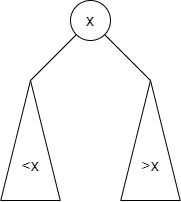
3-nodes:
There are different as they contain two attributes ordered so the first one is less than the second. It also references three children.
The first child containing a value less than the first attribute.
The second has a value between the first and second attributes.
And the last has a value greater than the second attribute.
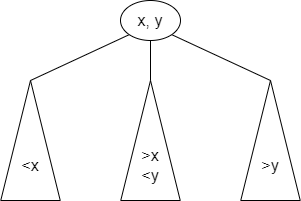
Important
The main property is that all the leaves are at the lowest level of the tree.
This is how this type of tree maintain the balance!
Activity
Consider the following tree.
Ensure that the property of a 2-3-tree is respected.
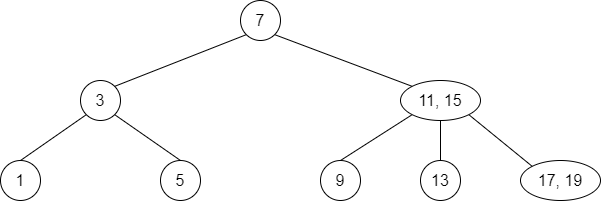
Think of a search strategy to find an element in a 2-3-tree.
7.1.1. Operations
2-3-trees are different from the regular binary search trees that we covered until now, so we need to redefine all the operations:
Search
Insert
Remove
7.1.2. Search
The search algorithm is more similar to the binary search tree that we could expect.
The pseudocode of the search can be written as follow:
1if the local root is null:
2 return null
3else if 2-node:
4 if item = data1:
5 return data1
6 else if item < data1:
7 recursively search the left subtree
8 else:
9 recursively search the right subtree
10else:
11 if item = data1:
12 return data1
13 else if item = data2:
14 return data2
15 else if item < data1:
16 recursively search the left subtree
17 else if item < data2:
18 recursively search the middle subtree
19 else:
20 recursively search the right subtree
Activity
Apply the previous algorithm to find if
13is in the following tree.

7.1.3. Insertion
When we insert a new item, we need to make sure that the tree stay balanced. The main difference with 2-3-trees is that the balance is down by building the tree from the bottom up and not the top down.
The idea:
Start by finding where to insert the new item by using the search method defined previously.
Insert the new item inside a node and not attached to a node.
Contrary to a regular binary search tree, we can be in three cases:
Case 1: Inserting into a 2-node leaf.
Case 2: Inserting into a 3-node leaf with 2-node parent.
Case 3: Inserting into a 3-node leaf with 3-node parent.
7.1.3.1. Case 1: 2-node leaf
This is the easiest case. If the leaf is a 2-node then there is enough space to insert an element inside it, thus creating a 3-node.
Example
Consider the tree on the left.
If we insert
15inside it, then we find a 2-node,11, that can accept a new item inside it.

7.1.3.2. Case 2: 3-node leaf with 2-node parent
This case happens when the node we want to insert the item is already a 3-node and the parent is a 2-node parent.
As 3-node cannot store three values, the strategy is to transform the parent node (which is a 2-node) to a 3-node by inserting the middle value in the parent directly.
However, if we do that the smallest item is not at the correct position in the tree, so we need to create a middle node for the parent containing the smallest value.
Example
Consider the tree in the previous example.
If we insert
17inside it, then we find a 3-node11, 15.This node cannot contain three values, so we take the middle value
15and insert it in the parent7.Now,
11is misplaced, so create a middle node of7, 15with11.The following trees shows the insertion step by step:
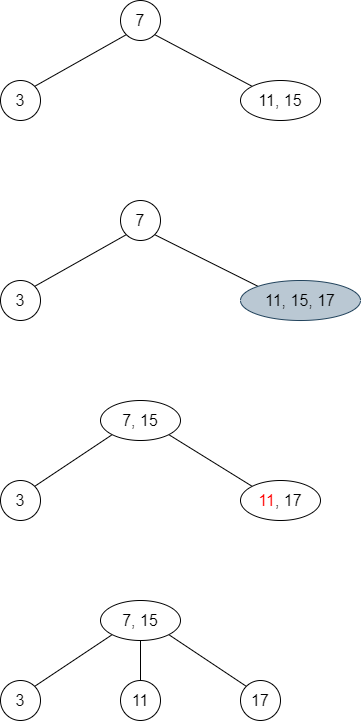
Activity
Insert
5,10and20.
7.1.3.3. Case 3: 3-node leaf with 3-node parent
This case happens when the node we want to insert the item is already a 3-node and the parent is also a 3-node parent.
As 3-node cannot store three values, we need to propagate up the middle value of the virtual node, as seen before.
However, the parent node is also a 3-node, so we apply the same strategy and propagate up again.
Example
Consider the following example.
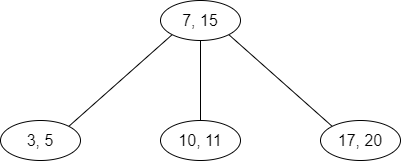
Now, if we insert
13, then a 3-node get a third value.
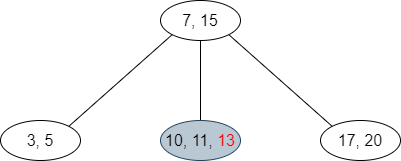
To solve that we propagate up the middle value (
11) of the node.
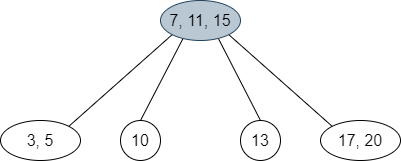
The parent was a 3-node, so we repeat the strategy and propagate up the middle value, creating a new root with two children.
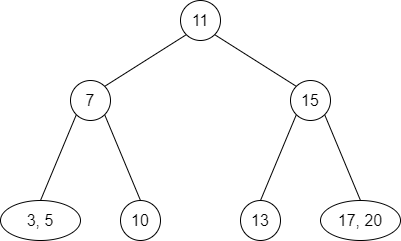
We can see that the properties of a 2-3-tree are followed.
The general pseudocode for insertion can be written as follow:
if root is null:
Create a 2-node with the new item
else if item in root:
return False
else if root is leaf:
if root is 2-node:
expand 2-node to 3 and insert item
else:
Create two 2-nodes and propagate up the new parent and the right child.
else:
if item < smaller item in local root:
insert left
else if local root is 2-node:
insert right
else if item < larger item in local root:
insert middle
else:
insert right
if new parent was propagated up:
if new parent will be the tree root:
Create 2-node with new parent
Left child is old parent
Right child is the propagated up child
The 2-node becomes the new parent
else:
Insert new parent at local root
return True
7.1.4. Analysis
Before going further we need to discuss the advantages of a 2-3-tree.
Activity
Discuss the advantages of a 2-3-tree against AVL trees or Red-Black Trees.
The number of items that can contain a 2-3-tree of height \(h\) is between \(2^h - 1\) and \(3^h - 1\).
Meaning that the height of 2-3-tree is between \(\log_3 n\) and \(\log_2 n\).
Thus the search time is \(O(\log n)\).
7.1.5. Deleting
Deleting an item is very similar to inserting an item.
The idea:
Find the item to remove.
If the item is a leaf -> remove it
Otherwise we swap it with its inorder predecessor in a leaf node and delete it in the leaf node.
If removing an item empty a leaf.
Items from the sibling and parent can be redistributed into that leaf.
Or the leaf can be merged with its parent and sibling.
Example
Consider the following tree:
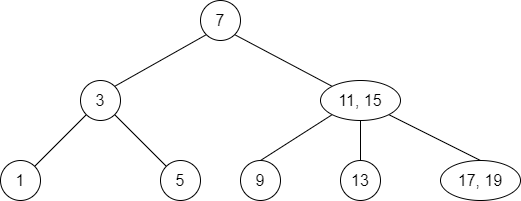
If we remove
13, the node becomes empty and15in the parent node will not have left child.We can merge
15with the right child creating the virtual node15, 17, 19.Then, we propagate up
17similarly to the insertion strategy.
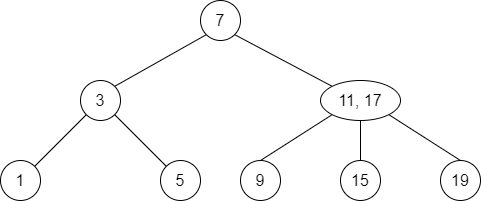
Now we remove
11.As it’s not a leaf we replace it with its predecessor
9.Now the leaf is empty, so we merge its right child
15.
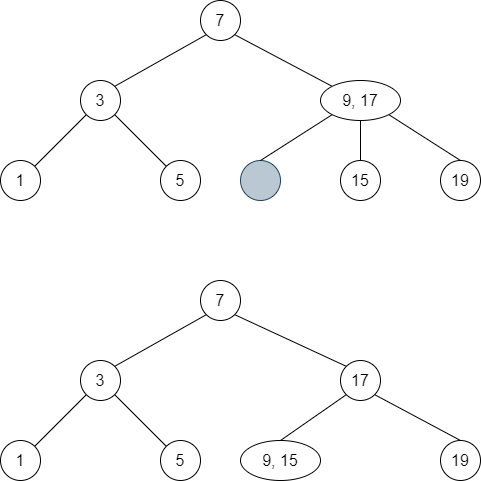
Finally, we remove
1.First we merge
3with its right child5; it empties3.So the process repeat with
7and its right child17.It becomes the root node.
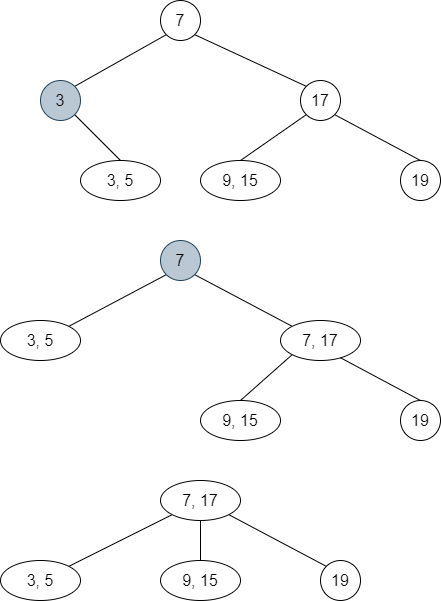
7.2. B-Trees
The 2-3-tree is inspired the B-trees which allow up to \(n\) children per node, where \(n\) can be a very large number.
Originally, B-trees are designed to build indexes to very large databases stored on a hard disk.
In the B-tree, the maximum number of children is the order of the B-tree.
The general properties for B-trees are:
Other than the root, each node has between
order/2andorderchildren.The number of items in a node is
number_of_children - 1.The data items in each node are ordered.
Below is an example of a B-tree:

Actvity
What is the order of the B-Tree?
7.2.1. Insertion
The insertion is similar to the 2-3-trees:
The new item is always inserted in a leaf.
If the leaf is not full, we are done.
Otherwise, if the leaf is full it is split into two nodes with the middle node propagated up.
If the root is being split, then the middle item becomes the new root.
Example
If we take the previous B-tree and we insert
17we obtain the following new tree.
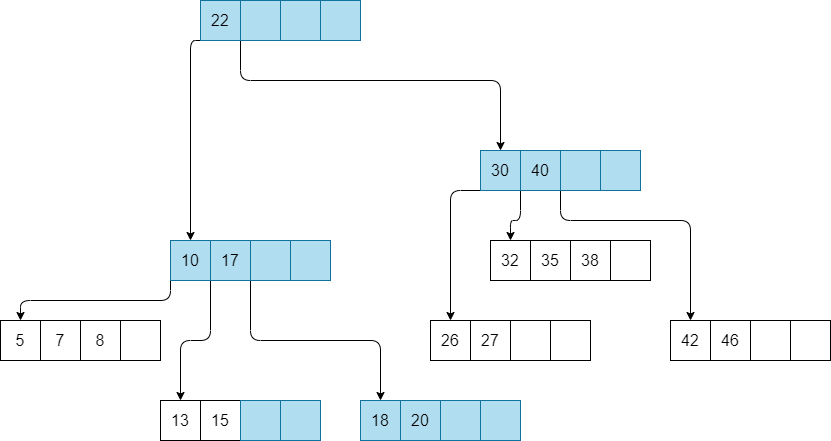
The pseudocode for insertion is:
if the root is null
Create a new Node that contains item
else search item in local root:
if item in local root:
return False
else:
if local root is leaf:
if local root is null:
insert new item
return null as the newChild and True to indicate successful insertion
else:
split local root
return newParent and newChild and True to indicate successful insertion
else:
recursively call insert
if newChild is not null:
if local root not null
insert newParent and newChild in local root
return null as the newChild and True to indicate successful insertion
else:
split local root
return newParent and newChild and True to indicate successful insertion
else:
return success/fail indicator for the insertion
Important
The code and pseudocode is the hardest covered in class. You’re not expected to be able to implement it, but you should understand how it works.
7.2.2. Deletion
Removing an item in a B-tree is a generalization of a removing an item from a 2-3-tree.
We can distinguish two main cases:
The item is in a leaf.
Then we just remove it.
If the item is in an interior node:
It can’t be deleted otherwise it will damage the B-tree properties.
The item must be replaced by its inorder predecessor.
We also need to consider the case in which deleting an item in a leaf results in a leaf being half full.
In this case, items from a sibling node and parent are redistributed into that leaf.
However if the sibling is itself exactly half full, the leaf, its parent item and siblings are merged into a single node.
Example
Consider the following B-tree.
If we remove
40, we are in the second case man case.
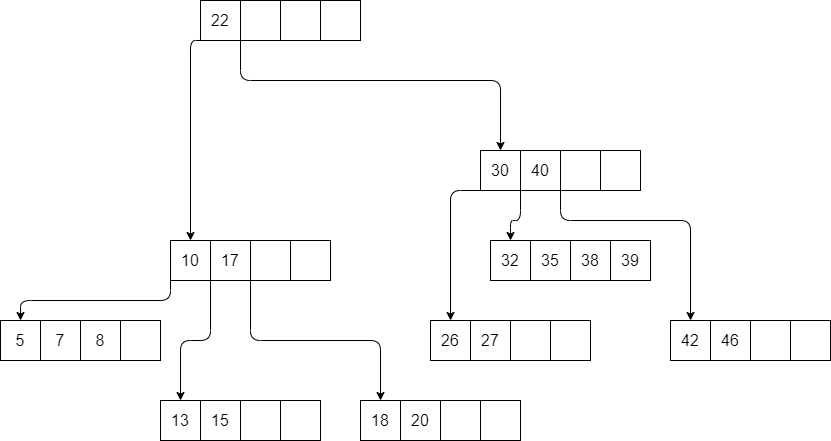
We replace its inorder predecessor.
In this case
39.
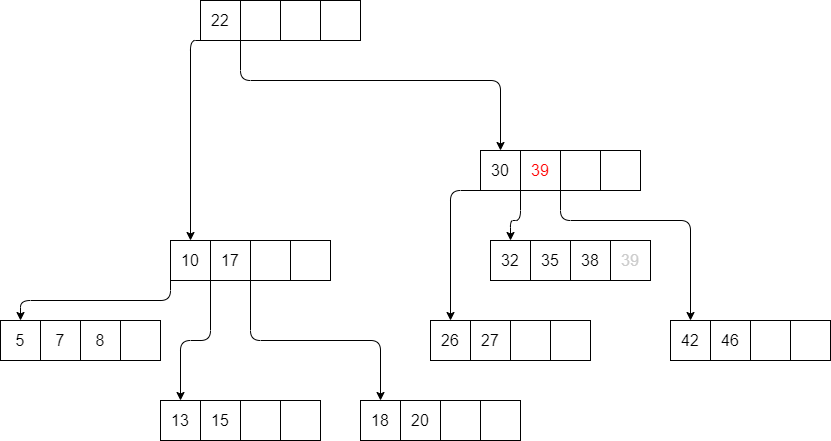
Now, we want to remove
18.If we remove it, the leaf will have less than half full.
Because the sibling is exactly half full, we can merge the parent item and the leaf together.
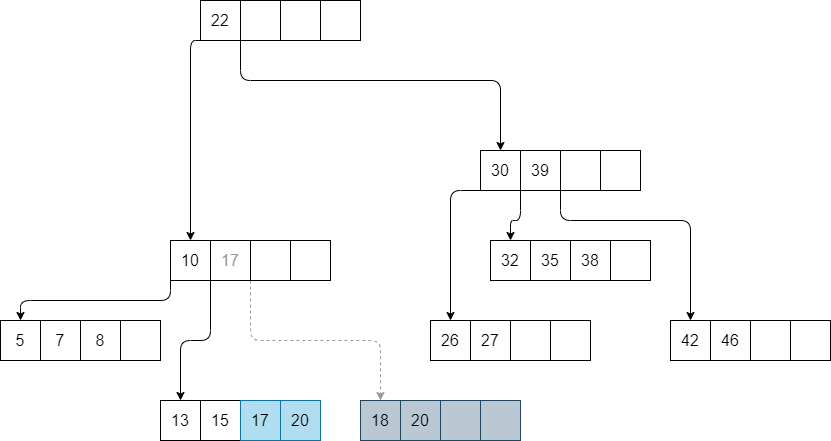
Once done, the parent node containing
10is less than half full.The sibling is also exactly half full, so we repeat the procedure.

The B-tree doesn’t break any B-tree properties so we can stop.